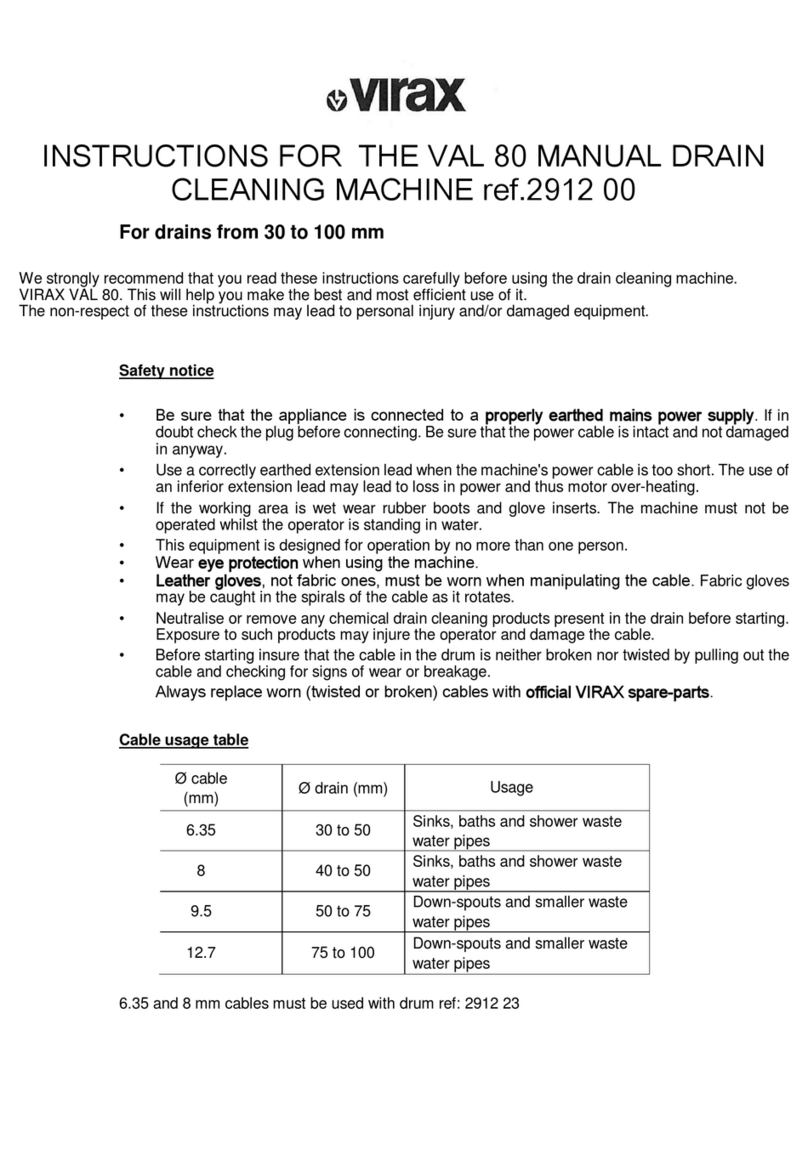Déclaration CE de Conformité
CE Declaration of Conformity - EG-Konformitätserklärung - Dichiarazione di conformità CE - Declaración de Conformidad
CE - Declaração CE de conformidade - CE-conformiteitsverklaring - Δήλωση συμμόρφωσης CE - Deklaracja zgodności CE
- Prohlášení ES o shodě – Декларация ЕС о соответствии - AT Uygunluk Beyanı –
NOUS, VIRAX S.A.S., DECLARONS SOUS NOTRE PROPRE RESPONSABILITE QUE LE(S) PRODUIT(S) :
WE, VIRAX S.A.S., DECLARE UNDER OUR OWN CIVIL REPONSIBILITY THAT THE PRODUCT(S):
WIR, DAS UNTERNEHMEN VIRAX S.A.S., ERKLÄREN AUF EIGENE VERANTWORTUNG, DASS DAS (DIE) PRODUKT(E):
LA SOTTOSCRITTA, VIRAX S.A.S., DICHIARA SOTTO LA PROPRIA RESPONSABILITÁ CHE IL(I) PRODOTTO(I):
NOSOTROS, VIRAX S.A.S., DECLARAMOS BAJO NUESTRA PROPIA RESPONSABILIDAD QUE EL(LOS) PRODUCTO(S):
NÓS, A VIRAX S.A.S., DECLARAMOS SOB NOSSA RESPONSABILIDADE QUE O(S) PRODUTO(S):
WIJ, VIRAX S.A.S., VERKLARING OP ONZE EIGEN VERANTWOORDELIJKHEID DAT HET/DE PRODUCT(EN) :
ΕΜΕΙΣ, Η VIRAX S.A.S., ΔΗΛΩΝΟΥΜΕ ΜΕ ΔΙΚΗ ΜΑΣ ΕΥΘΥΝΗ ΟΤΙ ΤΟ/ΤΑ ΠΡΟΪΟΝ/ΠΡΟΪΟΝΤΑ:
MY, VIRAX S.A.S., OŚWIADCZAMY Z PEŁNĄ ODPOWIEDZIALNOŚCIĄ, ŻE PRODUKT(Y):
MY, VIRAX S.A.S., PROHLAŠUJEME NA SVOU VLASTNÍ ODPOVĚDNOST, ŽE VÝROBEK (VÝROBKY):
МЫ, КОМПАНИЯ VIRAX S.A.S., ЗАЯВЛЯЕМ ПОД СВОЮ ОТВЕТСТВЕННОСТЬ, ЧТО ИЗДЕЛИЕ(Я):
BİZ, VIRAX S.A.S. OLARAK, KENDİ SORUMLULUĞUMUZ ALTINDA, ÜRÜN VE ÜRÜNLERİMİZİN AŞAĞIDA BELİRTİLEN :
VIRAX S.A.S
Ref. 295020 - désemboueuse /
•EST / SONT CONFORME(S) AUX DISPOSITIONS DE LA (DES) DIRECTIVE(S) EUROPENNE(S) SUIVANTE(S) :
CONFORM TO THE PROVISIONS IN THE FOLLOWING EUROPEAN DIRECTIVE(S) :
ÜBEREINSTIMMT/ÜBEREINSTIMMEN MIT DEN BESTIMMUNGEN DER FOLGENDEN EUROPÄISCHEN RICHTLINIE(N):
É / SONO CONFORME(I) ALLE DISPOSIZIONI DELLA(E) SEGUENTE(I) DIRETTIVA(E) EUROPEA(E):
ES / SON CONFORME(S) CON LAS DISPOSICIONES DE LA (DE LAS) DIRECTIVA(S) EUROPEA(S) SIGUIENTE(S):
ESTÁ(ÃO) EM CONFORMIDADE COM AS DISPOSIÇÕES DA(S) DIRECTIVA(S) EUROPEIA(S) SEGUINTE(S):
CONFORM IS/ZIJN MET DE BEPALINGEN VAN DE VOLGENDE EUROPESE RICHTLIJN(EN) :
ΣΥΜΜΟΡΦΩΝΕΤΑΙ/ΣΥΜΜΟΡΦΩΝΟΝΤΑΙ ΠΡΟΣ ΤΙΣ ΔΙΑΤΑΞΕΙΣ ΤΗΣ/ΤΩΝ ΑΚΟΛΟΥΘΗΣ/ΑΚΟΛΟΥΘΩΝ ΕΥΡΩΠΑΪΚΗΣ/ΕΥΡΩΠΑΪΚΩΝ ΟΔΗΓΙΑΣ/ΟΔΗΓΙΩΝ:
JEST/SĄ ZGODNY/-E Z PRZEPISAMI NASTĘPUJĄCYCH/-EJ DYREKTYW(Y) EUROPEJSKICH/-EJ:
ODPOVÍDÁ / ODPOVÍDAJÍ USTANOVENÍM NÁSLEDUJÍCÍ EVROPSKÉ SMĚRNICE (SMĚRNIC):
ОТВЕЧАЕТ(ЮТ) ПОЛОЖЕНИЮ (ЯМ) СЛЕДУЮЩЕЙ(ИХ) ЕВРОПЕЙСКОЙ(ИХ) ДИРЕКТИВЫ(ИВ) :
AVRUPA DİREKTİFLERİ TALİMATLARINA UYGUNLUĞUNU :
- MSD 2006/42/CE : Directive Machines / Machine Directive / Maschinenrichtlinie / Direttiva Macchine / Directiva Máquinas /
Directiva Máquinas / Machinerichtlijn / Οδηγία σχετικά με τα μηχανήματα / Dyrektywa maszynowa / směrnice o strojních zařízeních
/ Директива по машиностроению / Makine Direktifi /
- LVD 2006/95/CE : Directive Basse Tension / Low Voltage Directive / Niederspannungsrichtlinie / Direttiva bassa tensione /
Directiva Baja Tensión / Directiva Baixa Tensão / Laagspanningsrichtlijn / Οδηγία χαμηλής τάσης / Dyrektywa niskonapięciowa /
směrnice o nízkém napětí / Директива по низкому напряжению / Alçak Gerilim Direktifi /
- EMC 2004/108/CE : Directive Compatibilité Electromagnétique / Electromagnetic Compatibility Directive / Richtlinie über die
Elektromagnetische Verträglichkeit / Direttiva compatibilità elettromagnetica / Directiva Compatibilidad Electromagnética /
Directiva Compatibilidade Electromagnética / EMC-richtlijn (elektromagnetische compatibiliteit) / Οδηγία περί ηλεκτρομαγνητικής
συμβατότητας / Dyrektywa „Kompatybilność elektromagnetyczna / směrnice o elektromagnetické kompatibilitě/ Директива по
электромагнитной совместимости / Elektromanyetik Uyumluluk Direktifi /
•EST / SONT CONFORME(S) AUX DISPOSITIONS DE LA (DES) NORME(S) EUROPEENNE(S) HARMONISEE(S) SUIVANTE(S) :
CONFORM TO THE PROVISIONS IN THE FOLLOWING HARMONISED EUROPEAN STANDARD(S) :
ÜBEREINSTIMMT/ÜBEREINSTIMMEN MIT DEN BESTIMMUNGEN DER FOLGENDEN HARMONISIERTEN EUROPÄISCHEN NORMEN:
É / SONO CONFORME(I) ALLE DISPOSIZIONI DELLA(E) SEGUENTE(I) NORMA(E) EUROPEA(E) ARMONIZZATE(E):
ES / SON CONFORME(S) CON LAS DISPOSICIONES DE LA (LAS) NORMA(S) EUROPEA(S) ARMONIZADA(S) SIGUIENTE(S):
ESTÁ(ÃO) EM CONFORMIDADE COM AS DISPOSIÇÕES DA(S) NORMA(S) EUROPEIA(S) HARMONIZADA(S) SEGUINTE(S):
IS/ZIJN CONFORM MET DE BEPALINGEN VAN DE VOLGENDE GEHARMONISEERDE EUROPESE NORM(EN) :
ΣΥΜΜΟΡΦΩΝΕΤΑΙ/ΣΥΜΜΟΡΦΩΝΟΝΤΑΙ ΠΡΟΣ ΤΙΣ ΔΙΑΤΑΞΕΙΣ ΤΟΥ/ΤΩΝ ΑΚΟΛΟΥΘΟΥ/ΑΚΟΛΟΥΘΩΝ ΕΝΑΡΜΟΝΙΣΜΕΝΟΥ/ΕΝΑΡΜΟΝΙΣΜΕΝΩΝ
ΕΥΡΩΠΑΪΚΟΥ/ΕΥΡΩΠΑΪΚΩΝ ΠΡΟΤΥΠΟΥ/ΠΡΟΤΥΠΩΝ:
JEST/SĄ ZGODNY/-E Z PRZEPISAMI NASTĘPUJĄCYCH/-EJ ZHARMONIZOWANYCH/-EJ NORM(Y) EUROPEJSKICH/-EJ:
ODPOVÍDÁ / ODPOVÍDAJÍ USTANOVENÍM NÁSLEDUJÍCÍ HARMONIZOVANÉ EVROPSKÉ NORMY (NOREM):
ОТВЕЧАЕТ(ЮТ) ПОЛОЖЕНИЯМ СЛЕДУЮЩЕГО(ИХ) ГАРМОНИЗИРОВАННОГО(ЫХ) ЕВРОПЕЙСКОГО(ИХ) СТАНДАРТА(ОВ) :
UYUMLU HALE GETİRİLMİŞ AVRUPA STANDARTLARI TALİMATLARINA UYGUNLUĞUNU BEYAN EDERİZ :
EN 55014-1 : 2006 / EN 55014-2 : 1997 + A1 : 2001 ; EN 60335-1 ; EN 60335-2-79 ; EN 60745-1 + EN 60745-2 ; EN 50144-1 + EN 50144-2
E. Min, le Responsable Qualité / The Quality Manager / Der Leiter der Qualitätsabteilung / Il Responsabile Qualità / El Responsable de
Calidad / O responsável de qualidade / De Kwaliteitsverantwoordelijke / ΟΥπεύθυνος Ποιότητας / Kierownik ds. Jakości / Vedoucí
oddělení jakosti / Ответственный по качеству / Kalite Sorumlusu /
Le 01/10/2011
VIRAX - 39 quai de marne –51200 Epernay
France / Frankreich / Francia / França / Frankrijk / Γαλλία / Francja / Francie / Франция / Fransa /




























